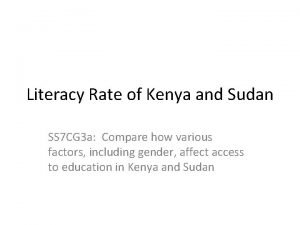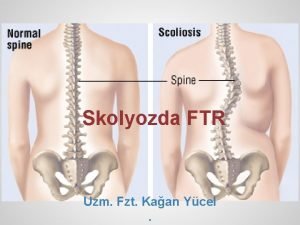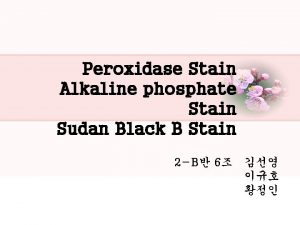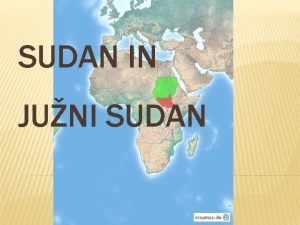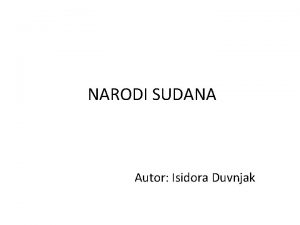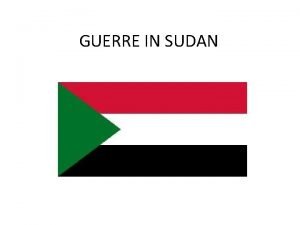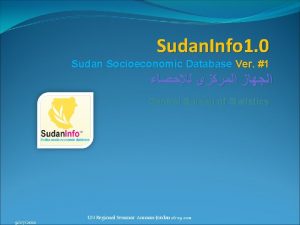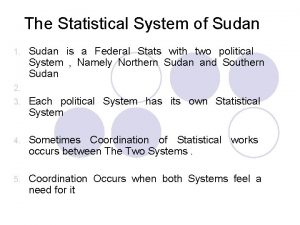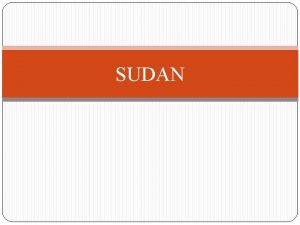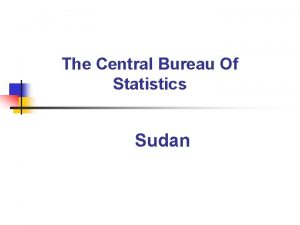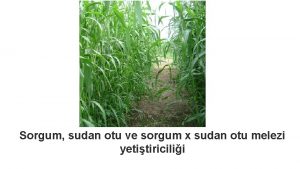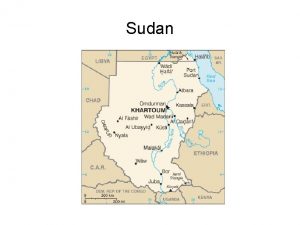SUDAN ICAC 13 th Meeting of the Inter





























- Slides: 29

SUDAN

ICAC -13 th Meeting of the Inter- Regional Cooperative Research Network on Cotton for the Mediterranean and Middle East Regions Luxor- Egypt February 2 - 6, 2018

Cotton grades and quality parameters as affected by boll Position By Neima. H. O. Suliman Agricultural Research Corporation (ARC) Cotton Research Program

Introduction ØCotton crop is one of the most important cash crops in the Sudan. It has a significant contribution in the export earnings. Therefore, great care should be given to factors that affect the final product to enhance homogeneity, grades and other quality parameters which have an important impact on cotton marketing.

Introduction Ø Bowman (1990), showed that, staple length, Micronaire value and strength have statistically significant impacts on cotton prices. Ø Ethridge (1987), found that, fibre strength and length uniformity had significant effects on the price of cotton, Furthermore, producer prices were most responsive to color and strength.

Introduction ØWang et al. (2009) indicated that fibre strength varied among the boll inserted location. ØZhao et al. (2012) showed that boll weight and fibre strength were affected by boll position, he also showed that the cellulose content and sucrose transformation rate changed with boll position, and consequently resulted in the change of boll weight and fibre strength. ØFibre length varies among fruiting sites (Bradow et al. , 1997).

Objective ØThe objective of this study was to investigate the seed cotton grades and quality parameters as affected by boll position.

Material and Methods Ø This study was conducted at the Gezira Research Station farm, Medani, Sudan for two consecutive seasons. The experiment was carried on a Randomized Complete Block Design (RCBD) comprising one variety Acala, with a plot size of 22. 4 square meters replicated three times. The recommended cultural and agronomic practices were adopted. Ø Fifteen samples were taken and each sample consisted of fifteen rows. One pick was taken and samples were taken for the top part (A), middle (B) and lower part ( C) of the plant.

Material and Methods ØEach zone was separately picked and subjected to grading according to Sudan seed cotton classification system and quality parameters tests were performed on samples taken.

Material and Methods Measurements obtained during the first season: - 1. Seed Index: weight of one hundred seeds in grams. (Hegab et al , 1985) 2. Lint Index: weight of lint obtained from one hundred seeds in grams. 3. Fibre Length(mm) measured as 2. 5% span length using the 530 Digital. Fibrograph Instrument 4. Micronaire value test using the portar instrument. 5. Maturity Ratio, obtained by the Finess/Maturity Tester (F. M. T). 6. Fibre Fineness test (millitex) obtained by the (F. M. T) Instrument. 7. Fibre bundle Strength (g/tex) using the stelometer instrument

Material and Methods Measurements undertaken during the second season included: - 1. Seed Index: weight of 100 seeds in grams 2. Lint Index : weight of lint obtained from one hundred seeds in grams 3. Fibre length (mm) measured using the High Volume Instrument (H. V. I). 4. Micronaire Value obtained by the H. V. I. 5. Fibre bundle Strength (g/tex) using the H. V. I.

Results and Discussion Table. 1 showed that, high grades of cotton ( clean cotton) were, obtained from upper part of the plant (A-zone), Grade (1) constituted 40% and 58% of the total for the two consecutive seasons , respectively. Grade (2) constituted 54% and 42%, respectively. Grade (3) constituted 6% and 0% of the total for the same seasons, respectively.

Ø At the middle part of the plant (B-Zone), Grade (1) constituted 13% and 29% of the total. Grade (2) constituted 69% and 69%, respectively. And Grade (3) constituted 18% and 2% of the total for the two seasons, respectively.

Ø At the lower part of the plant (C-zone), Grade (1) constituted 2% and 16% of the total for the two consecutive seasons. Grade (2) constituted 82% and 71%, respectively. Grade (3) constituted 16% and 13% of the total for the two seasons respectively.

ØThis was mainly attributed to that, cotton obtained from lower branches was contaminated with trash and soil which resulted in lint discoloration and poor appearance. On the other hand, cotton obtained from lower part had better quality measurements of seed index, fibre length …etc. as shown in table 5 and 9.

Ø The results pointed out to the significance of the quality parameters when seed cotton classification was based only on colour and trash content.

ØCotton obtained from middle part of plant (BZone) was more Homogenous (less C. V %) than upper and lower part of plant (table 10).

TABLE. 1 SAMPLES GRADES IN PERCENTAGE, IST AND 2 ND SEASON, VARIETY ACALA Boll Position Upper zone (A) 1 st season 2 nd season Middle zone (B) 1 st season 2 nd season Lower zone ( C ) 1 st season 2 nd season Grade% 1 40 58 13 29 2 16 2 54 42 69 69 82 71 3 6 0 18 2 16 13 100 100 100 Total %

Sample Table 2. Cotton Quality Parameters , upper zone-A , 1 st season , Variety Acala Seed Index ( g) Lint Index (g) Length (mm) Mat. Ratio Fin. (m/tex) 1 10. 67 5. 77 27. 83 3. 87 1. 02 145 19. 93 2 8. 58 5. 00 26. 57 3. 90 0. 95 159 21. 07 3 10. 13 5. 73 27. 13 4. 13 0. 96 164 20. 47 4 11. 47 5. 83 26. 77 4. 00 0. 92 176 19. 50 5 10. 50 5. 50 26. 90 3. 77 0. 88 175 21. 17 6 11. 00 5. 77 27. 37 3. 90 0. 90 172 19. 77 7 12. 00 6. 33 27. 27 3. 77 0. 92 162 20. 40 8 10. 07 5. 87 26. 60 2. 67 0. 91 159 20. 70 9 10. 50 5. 53 26. 93 3. 73 0. 89 174 18. 73 10 9. 83 5. 30 26. 13 3. 83 0. 91 172 20. 00 11 10. 57 5. 30 26. 43 4. 03 0. 90 19. 67 12 10. 70 5. 37 26. 23 3. 83 0. 93 162 20. 17 13 9. 63 5. 10 27. 30 3. 60 0. 94 150 18. 87 14 9. 60 4. 47 26. 50 3. 37 0. 83 169 19. 20 15 9. 90 5. 70 27. 13 3. 47 0. 92 169 18. 93 Mean 10. 34 5. 50 26. 87 3. 79 0. 92 167 19. 90 C. V% 9. 51 10. 41 2. 39 10. 11 6. 25 11. 72 4. 86 C. V% Coefficient of Variation Mic. Value Str. (g/tex)

Table 3. Cotton Quality Parameters, middle zone- B, 1 st season , Variety Acala. Sample Seed Index ( g) Lint Index (g) Length (mm) Mic. Value Mat. Ratio Fin. (m/tex) Str. (g/tex) 1 11. 33 5. 97 27. 17 4. 23 0. 96 177 20. 40 2 11. 03 5. 87 26. 77 4. 00 0. 93 173 20. 43 3 10. 97 6. 00 26. 93 4. 27 0. 95 179 20. 67 4 11. 17 5. 93 27. 90 4. 03 0. 93 170 21. 13 5 10. 30 6. 00 27. 43 4. 10 0. 94 175 20. 87 6 11. 03 5. 97 28. 17 4. 33 0. 98 173 20. 50 7 10. 37 5. 50 27. 77 4. 03 0. 93 169 20. 30 8 10. 47 5. 70 26. 87 4. 07 0. 93 173 20. 07 9 11. 40 6. 40 27. 30 4. 03 0. 94 171 19. 37 10 10. 83 5. 83 27. 60 3. 97 0. 93 170 20. 67 11 10. 77 6. 13 27. 43 3. 67 0. 86 177 20. 80 12 10. 60 5. 87 28. 13 4. 03 0. 92 176 20. 87 13 10. 63 5. 70 26. 60 4. 13 0. 98 162 19. 50 14 9. 70 5. 67 27. 77 3. 73 0. 92 161 19. 60 15 10. 70 5. 93 27. 37 3. 80 0. 95 156 20. 43 Mean 10. 75 5. 89 27. 41 4. 03 0. 94 171 20. 37 C. V% 7. 72 9. 11 2. 90 6. 01 5. 48 6. 56 6. 53 C. V% Coefficient of Variation

Table 4. Cotton Quality Parameters, lower zone – C, 1 st season, Variety Acala. Sample Seed Index ( g) Lint Index (g) Length (mm) Mic. Value Mat. Ratio Fin. (m/tex) Str. (g/tex) 1 10. 80 5. 57 27. 90 4. 07 0. 96 169 19. 57 2 9. 90 5. 27 27. 67 4. 03 0. 94 164 19. 90 3 11. 77 6. 17 28. 33 4. 20 0. 97 171 21. 53 4 10. 93 5. 77 28. 17 4. 13 0. 94 180 21. 93 5 11. 63 6. 13 28. 10 4. 23 0. 98 165 20. 43 6 11. 00 5. 87 28. 70 4. 03 0. 95 167 20. 63 7 10. 03 5. 20 27. 03 4. 00 0. 92 170 19. 60 8 10. 73 5. 67 26. 83 4. 20 0. 97 176 21. 33 9 11. 37 5. 87 27. 97 4. 23 0. 96 176 19. 53 10 11. 13 5. 47 26. 30 3. 63 0. 95 162 20. 67 11 10. 67 5. 17 27. 23 3. 83 0. 95 157 19. 83 12 10. 60 5. 73 27. 73 3. 97 0. 93 170 20. 20 13 10. 14 4. 90 26. 93 3. 93 0. 95 161 20. 43 14 9. 83 4. 97 28. 80 3. 67 0. 89 169 20. 40 15 11. 60 5. 87 28. 80 3. 30 0. 88 153 19. 63 Mean 10. 81 5. 58 27. 77 3. 96 0. 94 0. 167 20. 37 C. V% 9. 54 10. 97 2. 53 8. 07 6. 18 5. 80 6. 91 C. V% Coefficient of Variation

Table 5. Means of cotton quality parameters for different zones, 1 st season, variety Acala. Properties Upper Zone (A) Middle Zone (B) Lower Zone ( C ) Seed Index(g) 10. 34 10. 75 10. 81 Lint Index(g) 5. 50 5. 89 5. 58 Fibre Length (mm) 26. 87 27. 41 27. 77 Micronaire Value 3. 79 4. 03 3. 96 Maturity Ratio 0. 92 0. 94 Fibre Fineness 167. 0 171. 0 167. 0 Strength g/tex 19. 90 20. 37

6. Cotton Quality Parameters , upper zone- A , 2 Sample nd season, Variety Acala. Seed Index (g) Lint Index (g) Length (mm) Mic. Value. Str. (g/tex) 1 11. 47 6. 37 30. 30 4. 23 26. 63 2 12. 20 6. 13 30. 40 4. 03 25. 77 3 12. 47 6. 70 30. 13 4. 53 24. 37 4 12. 47 6. 60 30. 20 4. 60 24. 33 5 11. 50 6. 20 30. 33 4. 27 25. 73 6 13. 40 6. 97 30. 50 4. 17 27. 00 7 11. 70 6. 10 30. 57 3. 97 26. 87 8 11. 80 6. 53 29. 70 4. 20 27. 30 9 12. 13 6. 30 30. 63 4. 13 27. 00 10 12. 30 6. 63 31. 70 4. 03 28. 03 11 12. 73 6. 57 30. 47 4. 40 25. 13 12 12. 40 6. 40 29. 07 4. 07 25. 63 13 10. 50 6. 77 29. 73 3. 87 27. 30 14 10. 80 6. 40 29. 87 4. 23 25. 40 15 11. 87 6. 37 29. 67 4. 13 25. 20 Mean 11. 98 6. 40 30. 22 4. 19 26. 11 C. V 9. 87 10. 19 3. 82 7. 34 5. 37 C. V% Coefficient of Variation

Table 7. Cotton Quality Parameters, middle zone –B, 2 nd season , Variety Acala. Sample Seed Index(g) Lint Index (g) Length (mm) Mic. Value. Str. (g /tex) 11. 70 6. 33 29. 97 4. 43 25. 06 2 13. 07 6. 63 29. 57 4. 27 2. 43 3 12. 80 6. 87 29. 90 4. 57 24. 63 4 13. 00 6. 30 30. 30 4. 53 25. 00 5 12. 80 6. 63 30. 33 4. 43 25. 63 6 11. 67 6. 30 30. 30 4. 40 26. 17 7 11. 47 6. 23 30. 87 4. 17 26. 23 8 12. 00 6. 57 30. 03 4. 03 26. 53 9 12. 37 6. 73 30. 13 4. 23 27. 20 10 11. 60 5. 67 29. 60 4. 07 27. 27 11 11. 87 6. 40 29. 67 4. 33 24. 87 12 11. 97 6. 13 30. 47 4. 23 25. 80 13 11. 30 5. 83 30. 10 3. 83 27. 10 14 13. 00 6. 87 29. 90 4. 43 26. 80 15 11. 90 6. 20 30. 43 4. 03 25. 30 Mean 12. 17 6. 38 30. 10 4. 27 25. 91 C. V 8. 64 7. 51 3. 77 7. 15 6. 39 1 C. V% Coefficient of Variation

Table 8. Cotton Quality Parameters, lower zone- C, 2 nd season, Variety Acala. Sample Seed Index (g) Lint Index (g) Length (mm) Mic. Value. Str. (g/tex) 1 13. 07 6. 8 30. 57 4. 47 25. 00 2 11. 63 6. 1 29. 57 4. 00 25. 13 3 12. 70 7. 1 30. 30 4. 50 25. 87 4 12. 43 6. 47 30. 77 4. 43 27. 87 5 13. 30 6. 80 30. 70 4. 33 27. 13 6 11. 73 5. 97 30. 37 4. 43 26. 07 7 12. 00 6. 27 31. 03 4. 10 26. 73 8 12. 47 6. 83 30. 17 4. 03 26. 83 9 12. 40 6. 53 30. 67 3. 97 28. 47 10 12. 27 6. 23 29. 93 4. 30 28. 10 11 12. 43 6. 23 30. 37 4. 47 25. 93 12 13. 37 6. 57 29. 73 3. 93 26. 70 13 11. 43 6. 10 29. 73 3. 87 25. 33 14 12. 50 6. 27 30. 40 4. 20 25. 87 15 13. 20 5. 87 30. 20 4. 03 27. 47 Mean 12. 46 6. 41 30. 30 4. 20 26. 57 C. V% 8. 39 7. 98 3. 36 7. 98 - C. V% Coefficient of Variation

Table (9) Means of cotton quality parameters for different zones, 2 nd season, variety Acala. Properties Upper Zone (A) Middle Zone (B) Lower Zone ( C ) Seed Index (g) 11. 98 12. 17 12. 46 Lint Index (g) 6. 40 6. 38 6. 41 Fibre Length(mm) 30. 22 30. 10 30. 30 Micronaire Value 4. 19 4. 27 4. 20 Fibre Strength (g/tex) 26. 11 25. 91 26. 57

Table (10) Coefficient of variation (C. V) for cotton quality parameters for different plants zones. Properties Upper Zone (A) Middle Zone (B ) Lower Zone ( C) 1 st 2 nd Seed Index 9. 51 9. 87 7. 72 8. 64 9. 54 8. 39 Lint Index 10. 41 10. 19 9. 11 7. 51 10. 97 7. 98 Length 2. 39 3. 82 2. 90 3. 77 2. 53 3. 36 Micronaire 10. 11 7. 34 6. 01 7. 15 8. 07 9. 98 6. 25 - 5. 48 - 6. 18 - Fineness 11. 72 - 6. 56 - 5. 80 - Strength 4. 86 5. 37 6. 53 6. 39 6. 91 - Value Maturity Ratio

Recommendations 1. Open cotton should not be left too long in the field, and more frequent pickings should be practiced. 2. In case of delaying picking date, plant should be divided to three zones and every zone should be separately picked. 3. Classification should include fibre characteristics beside grade. 4. Cotton should be sold on the basis of grade and quality parameters at a time.

Thank you for your kind attention
 What is meeting and types of meeting
What is meeting and types of meeting Types of meeting
Types of meeting For today's meeting
For today's meeting Today meeting or today's meeting
Today meeting or today's meeting Sudanese electricity distribution company
Sudanese electricity distribution company Ethanol test for fats
Ethanol test for fats Inso south sudan
Inso south sudan History of nursing in sudan
History of nursing in sudan National audit chamber sudan
National audit chamber sudan Pas principle
Pas principle Hilo mur
Hilo mur Sudan black
Sudan black Ameba es unicelular o pluricelular
Ameba es unicelular o pluricelular What is the literacy rate in sudan
What is the literacy rate in sudan Winwin south sudan
Winwin south sudan Konflikt na bliskim wschodzie tomaszewska
Konflikt na bliskim wschodzie tomaszewska Fonksiyonel skolyoz
Fonksiyonel skolyoz Ipsilateral egzersiz
Ipsilateral egzersiz Karanlık gecede kara sudan zap suyuna giden yol
Karanlık gecede kara sudan zap suyuna giden yol In sudan
In sudan Cpi
Cpi Myeloperoxidase stain
Myeloperoxidase stain Sudan iii indicator biomolecules
Sudan iii indicator biomolecules Các châu lục và đại dương trên thế giới
Các châu lục và đại dương trên thế giới Thang điểm glasgow
Thang điểm glasgow Thế nào là hệ số cao nhất
Thế nào là hệ số cao nhất ưu thế lai là gì
ưu thế lai là gì Hệ hô hấp
Hệ hô hấp Tư thế ngồi viết
Tư thế ngồi viết Cái miệng nó xinh thế
Cái miệng nó xinh thế













